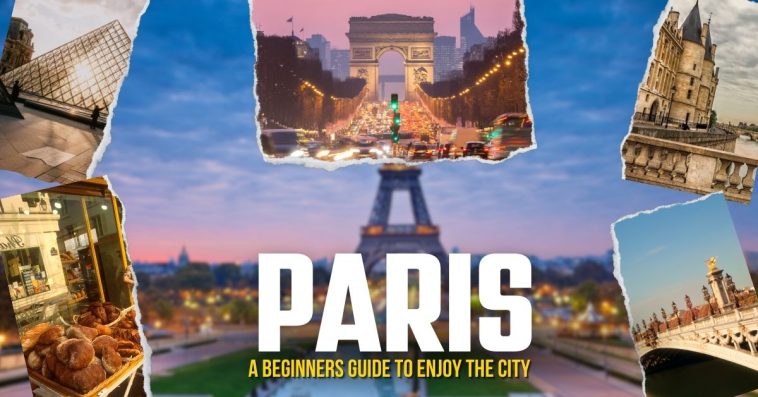Paris, the capital of France, is more than just a city—it’s an experience. Renowned for its timeless charm, iconic architecture, and unparalleled romance, this travel guide to Paris will enchant every visitor with its café-lined streets, the aroma of freshly baked croissants, and a sophisticated culture that permeates every corner. Whether you’re drawn to its rich history, fashion-forward lifestyle, or world-class cuisine, Paris is a city that leaves a lasting impression on all who visit.
Travel Guide to Paris—A Beginners Guide To Enjoy The City
This guide will take you through everything you need to know for an unforgettable trip to the City of Light. From how to get there and where to stay to the best sights, activities, and dining options, this travel guide to Paris is your ultimate companion.
Getting to Paris
Paris is a highly accessible destination with multiple travel options that cater to every budget and preference, ensuring your journey to the City of Light is as smooth and enjoyable as possible:
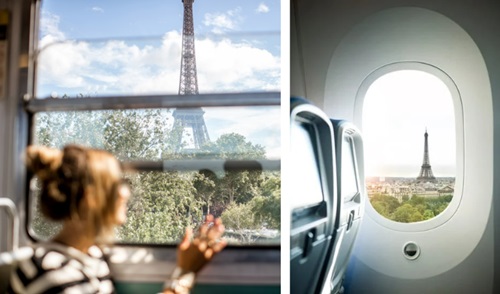
By Air
- Charles de Gaulle Airport (CDG): As France’s largest international airport, CDG handles millions of passengers each year and offers an extensive range of global flights. Inside, you’ll find a variety of amenities including duty-free shops, lounges, and diverse dining options to make your transit comfortable. The RER B train connects the airport directly to the city center in about 35 minutes, while Le Bus Direct and numerous shuttle services provide convenient alternatives.
- Orly Airport (ORY): Located closer to the city, Orly serves primarily European and domestic flights. It features modern facilities with ample shopping and dining choices. The Orlyval light rail links to the RER B, making it easy to reach central Paris. Additionally, buses and taxis are readily available for direct transfers.
- Paris Beauvais Airport (BVA): Often used by low-cost carriers, Beauvais is situated about 85 kilometers from Paris. While it’s a bit farther, budget travelers can take a dedicated shuttle bus from the airport to Porte Maillot in Paris, a journey that takes approximately 1 hour and 15 minutes.
By Train
- Eurostar: The high-speed Eurostar train connects London St Pancras International to Paris Gare du Nord in just over two hours. Traveling through the Channel Tunnel, it offers a seamless and scenic route, making it a favorite for travelers coming from the UK.
- TGV (Train à Grande Vitesse): France’s high-speed TGV trains link Paris to major cities across France and Europe, including Lyon, Marseille, Brussels, and Barcelona. These trains are known for their punctuality, comfort, and speed, allowing you to reach Paris from neighboring countries in just a few hours.
- Thalys: Another high-speed option, Thalys trains connect Paris with cities like Amsterdam, Cologne, and Brussels. With multiple daily departures, Thalys offers flexibility and convenience for international travelers.
By Road
- Bus Services: Companies like FlixBus, BlaBlaCar Bus, and Ouibus provide affordable and frequent services to Paris from various European cities. Modern buses are equipped with comfortable seating, Wi-Fi, and power outlets, making long journeys more pleasant.
- Driving: If you prefer the freedom of your own vehicle, driving to Paris is an option. Major highways such as the A1, A4, and A6 connect Paris to neighboring regions and countries. However, be prepared for heavy traffic and limited parking in the city center. Utilizing parking garages or park-and-ride facilities on the outskirts can help alleviate these challenges.
By Ferry
- From the UK: For those traveling from the United Kingdom, ferries depart from ports like Dover, Newhaven, and Portsmouth, docking at Calais, Dieppe, or Le Havre. After disembarking, you can continue your journey to Paris by train, bus, or car. The ferry ride itself offers stunning views of the English Channel, making for a picturesque start to your Parisian adventure.
Travel Tips
- Booking in Advance: Whether flying, taking the train, or hopping on a bus, booking your tickets well in advance can help you secure the best prices and preferred departure times, especially during peak travel seasons.
- Navigating Airports: Familiarize yourself with the layout of your arrival airport to streamline your transfer to the city. Both CDG and ORY offer comprehensive maps and traveler assistance services.
- Travel Passes: Consider purchasing a Paris Visite Pass or other transportation passes that can save you money and time when navigating the city’s public transport system upon arrival.
- Luggage Considerations: Check the luggage policies of your chosen transport mode. High-speed trains like the Eurostar and TGV have generous baggage allowances, while budget airlines and buses may have stricter limits.
By choosing the right mode of transportation and planning ahead, your journey to Paris can be the beginning of an unforgettable adventure in one of the world’s most enchanting cities.
Where to Stay
Paris offers a wide variety of accommodations, ensuring every traveler finds the perfect place to suit their style and budget. The city’s diverse neighborhoods, or arrondissements, each offer unique charm and advantages, making it essential to choose one that matches your preferences.
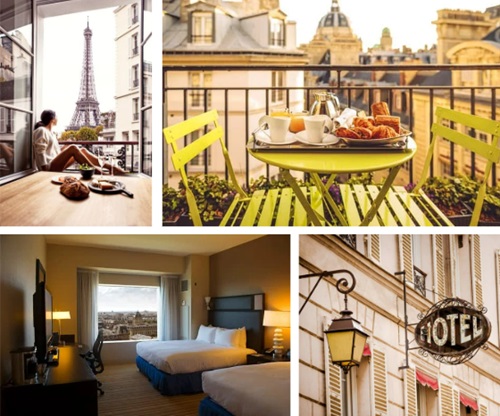
Luxury Seekers
For those looking to indulge in Parisian opulence, the city boasts some of the finest luxury hotels in the world:
- Neighborhoods to Explore: The 8th arrondissement, home to the Champs-Élysées and Avenue Montaigne, is ideal for high-end stays. The Saint-Germain-des-Prés area in the 6th arrondissement is another excellent choice, offering a mix of historic charm and luxurious boutique hotels.
- Top Picks: Iconic names like The Ritz Paris, Le Meurice, and Shangri-La Hotel deliver an unmatched blend of elegance, comfort, and prime locations near major attractions. Many of these properties also feature Michelin-starred restaurants and world-class spas.
Mid-Range Travelers
For a balance of comfort, charm, and affordability, Paris has an abundance of boutique hotels and quaint accommodations:
- Where to Stay: The Le Marais district (3rd and 4th arrondissements) is a favorite for its trendy vibe, historic architecture, and proximity to attractions like the Musée Picasso and Place des Vosges. Montmartre in the 18th arrondissement is another excellent option, known for its artistic flair and bohemian streets.
- Unique Options: Look for boutique hotels like Hôtel des Grands Boulevards or Hôtel du Petit Moulin, which often feature stylish interiors, friendly service, and local charm.
Budget-Friendly Options
For travelers on a tighter budget, Paris still offers plenty of options without sacrificing quality or convenience:
- Affordable Areas: Neighborhoods such as Bastille (11th arrondissement) or Canal Saint-Martin (10th arrondissement) provide budget-friendly accommodations and vibrant local scenes. These areas are slightly off the main tourist path but are well-connected by public transport.
- Hostels and Budget Hotels: Paris boasts several excellent hostels, such as Generator Paris and St. Christopher’s Inn, which offer private rooms, dormitories, and shared communal spaces. Budget hotels like Hôtel Darcet or Ibis Styles provide no-frills comfort and central locations.
Specialty Stays
For those seeking unique and memorable accommodations, consider:
- Historic Hotels: Stay in a piece of history at properties like Hôtel de Crillon, which dates back to the 18th century, or Relais Christine, housed in a former abbey.
- Airbnbs & Short-Term Rentals: Perfect for families or groups, short-term rental apartments offer more space and the option to cook your own meals. Look for stays in central neighborhoods like Latin Quarter (5th arrondissement) for easy access to sights.
- Eco-Friendly Hotels: Increasingly popular in Paris, eco-conscious travelers can check out sustainable hotels like Hôtel Gavarni or Le Citizen Hotel, which prioritize environmental responsibility.
Booking Tips
- Plan Ahead: Paris is one of the most visited cities in the world, so booking accommodations well in advance is highly recommended, especially during peak seasons like spring, summer, and fashion week.
- Consider Transportation: Choose a hotel near a Métro station to simplify getting around the city. Most of Paris’s main attractions are easily accessible via its extensive public transport network.
- Think Local: Staying in a local neighborhood like Belleville or Batignolles offers a more authentic Parisian experience, with quieter streets and smaller cafés, away from tourist-heavy areas.
- Look for Deals: Off-season travel (late autumn or winter) often means lower rates and less competition for top accommodations.
Wherever you choose to stay, Paris’s charm will make every moment unforgettable, with accommodations to suit every taste and need. From luxury palaces to hidden budget gems, there’s something for everyone in the City of Light.
Dining and Drinking in Paris
Paris is a food lover’s paradise, offering a culinary scene that combines traditional French gastronomy with innovative global influences. Whether you’re savoring a flaky croissant at a neighborhood café or indulging in a multi-course Michelin-starred meal, every bite in Paris is an experience to remember.
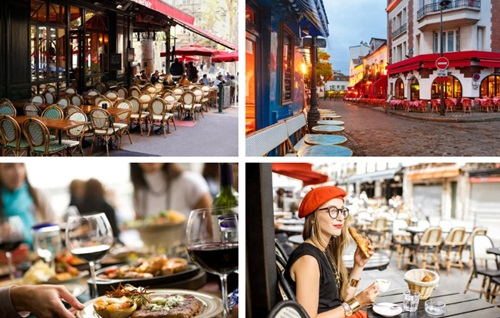
Café Culture
- The Parisian Ritual: A morning in Paris often begins at a sidewalk café with a cup of strong espresso paired with a buttery croissant or pain au chocolat. Parisians take their time, enjoying the quiet charm of people-watching and casual conversations. Popular spots like Café de Flore or Les Deux Magots in Saint-Germain-des-Prés are legendary for their historical significance and chic atmosphere.
- All-Day Cafés: Many cafés also serve as casual bistros, offering hearty dishes like quiche Lorraine or croque monsieur during lunch hours.
Must-Try Dishes
Paris’s culinary repertoire is vast, but some dishes are simply unmissable:
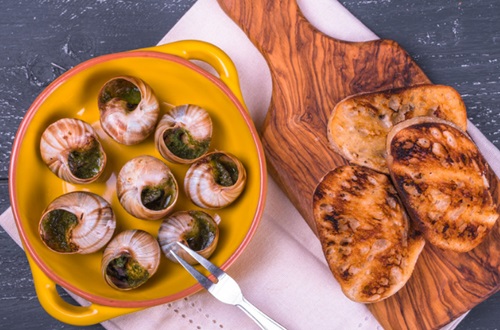
- Escargots de Bourgogne: Snails cooked with garlic, butter, and parsley—an indulgent and quintessentially French appetizer.
- Ratatouille: A vegetable medley that’s a treat for vegetarians and a staple of French home cooking.
- Coq au Vin: A slow-cooked chicken dish braised in red wine with mushrooms and onions, showcasing the elegance of French flavors.
- Steak Frites: Juicy steak paired with crispy golden fries, a favorite at Parisian brasseries.
- Desserts: End your meal with crème brûlée, profiteroles, or a fresh fruit tartelette.
Wine and Cheese
- Wine Pairings: France is world-renowned for its wine, and Paris is the perfect place to explore its variety. Pair a robust Bordeaux with red meat or sip a light Sancerre alongside fresh seafood.
- Cheese Heaven: From creamy Brie de Meaux to pungent Roquefort, Paris offers cheese selections that pair beautifully with bread and wine. Many restaurants feature cheese plates (plateau de fromage) to conclude a meal.
- Wine Bars: Visit cozy wine bars like Le Barav or La Cave des Climats for expertly curated wine lists and knowledgeable sommeliers.
Dining Options
- Michelin-Starred Restaurants: Paris boasts over 100 Michelin-starred establishments, including the legendary Le Meurice Alain Ducasse and L’Ambroisie, offering once-in-a-lifetime dining experiences.
- Bistros and Brasseries: Casual yet elegant, these establishments are perfect for experiencing French classics in a relaxed setting. Le Procope, one of the oldest brasseries, offers both history and delicious meals.
- Global Cuisine: Paris’s diverse population has influenced its food scene. Try North African couscous in Belleville, Vietnamese pho in the 13th arrondissement, or Italian trattorias scattered across the city.
Street Food and Markets
- Crepes and Galettes: Street-side crepe stands are a must-visit, offering sweet options like Nutella or savory ones filled with ham and cheese.
- Marché des Enfants Rouges: This historic covered market in Le Marais is a foodie paradise, with stalls selling everything from Moroccan tagines to freshly baked pastries.
- Baguette on the Go: Pick up a freshly baked baguette from a local boulangerie for a simple, satisfying snack.
Drinking in Paris
- Cocktail Bars: The Paris cocktail scene is thriving, with speakeasies like Little Red Door and sophisticated lounges like Bar Hemingway in The Ritz Paris setting the standard.
- Beer Culture: While wine dominates, Paris is home to an emerging craft beer scene. Head to Paname Brewing Company or La Fine Mousse to sample local brews.
- Aperitif Culture: Parisians love their apéritif, a pre-dinner drink to stimulate the appetite. Popular choices include pastis, kir, or a glass of Champagne.
Dining Tips
- Reservations Are Key: Many popular restaurants require reservations, especially for dinner. Book ahead to secure your spot.
- Timing Matters: Lunch is typically served from 12:00 PM to 2:00 PM, and dinner starts around 7:30 PM. Many restaurants close between lunch and dinner service.
- Tipping: A service charge (service compris) is often included in the bill, but it’s customary to round up or leave small change as a gesture of appreciation.
- Venture Off the Beaten Path: While iconic spots are tempting, some of Paris’s most memorable meals can be found in less touristy neighborhoods like Oberkampf or Canal Saint-Martin.
With its rich culinary traditions, diverse flavors, and a dining culture that celebrates both food and life, Paris offers an unforgettable gastronomic journey. Whether you’re sipping wine at a charming café or savoring haute cuisine in an elegant restaurant, every meal is a celebration in the City of Light.
A Journey Through History
Paris boasts over 2,000 years of history, marked by pivotal events and cultural evolution. Its roots stretch back to 52 BC, when the Romans overtook the region. The city later became a hub of art, science, and political revolution, playing a central role in the French Revolution of 1789.
Despite its turbulent past, Paris emerged as a beacon of beauty, culture, and resilience. Today, its cobblestone streets and grand boulevards are living reminders of its illustrious history, from the medieval Notre Dame Cathedral to the opulent Palace of Versailles.
Top Sights and Must-See Attractions
Paris is a treasure trove of iconic landmarks and hidden gems, each offering a glimpse into the city’s rich history, artistic legacy, and enchanting beauty. Whether you’re visiting for the first time or returning to rediscover its magic, these top sights are must-sees during your trip.
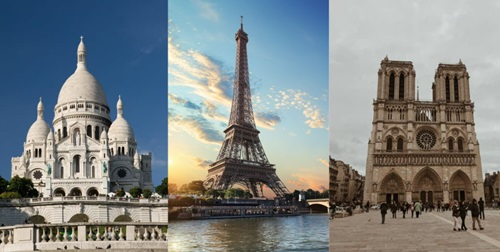
The Eiffel Tower
No trip to Paris is complete without visiting the world-renowned Eiffel Tower.
- Why Visit: Standing at 330 meters tall, this masterpiece of iron engineering is not just a symbol of Paris but also an architectural marvel.
- What to Do: Take the elevator or climb the stairs to one of its viewing platforms for breathtaking panoramic views of the city. At night, watch the tower sparkle with its dazzling light show every hour.
- Pro Tip: Book your tickets online to skip long queues and consider dining at Le 58 Tour Eiffel or the Michelin-starred Jules Verne restaurant for a memorable experience.
The Louvre Museum
The Louvre, the world’s largest art museum, is a must for art and history lovers.
- Why Visit: Home to over 35,000 works of art, including the Mona Lisa and the Venus de Milo, the Louvre is a journey through centuries of human creativity.
- What to Do: Stroll through its vast galleries, explore its medieval moat, and admire the iconic glass pyramid designed by I.M. Pei.
- Pro Tip: Visit early in the morning or late in the evening to avoid crowds, and plan your route in advance to focus on highlights.
Notre-Dame Cathedral
The Notre-Dame de Paris is a masterpiece of Gothic architecture that has stood for over 850 years.
- Why Visit: Its intricate stonework, soaring towers, and stunning stained-glass windows are a testament to medieval craftsmanship.
- What to Do: Climb the bell towers for an up-close look at the famous gargoyles and enjoy unparalleled views of Île de la Cité. The interior restoration (after the 2019 fire) has brought new life to its breathtaking beauty.
- Pro Tip: Arrive early to beat the lines and take a serene walk along the Seine afterward.
Montmartre and Sacré-Cœur
The Montmartre district is a bohemian haven, and at its peak lies the Sacré-Cœur Basilica.
- Why Visit: Known for its artistic history as the home of Picasso and Van Gogh, Montmartre exudes charm with its cobblestone streets, quaint cafés, and vibrant atmosphere.
- What to Do: Visit the Basilica for its striking white domes and panoramic views of Paris from the terrace. Wander through Place du Tertre to see local artists at work.
- Pro Tip: Explore at sunset to experience the neighborhood’s magical ambiance and enjoy a cozy dinner at a nearby bistro.
The Champs-Élysées and Arc de Triomphe
The Champs-Élysées, often dubbed “the most beautiful avenue in the world,” leads to the majestic Arc de Triomphe.
- Why Visit: This historic boulevard is lined with luxury boutiques, theaters, and cafés, making it perfect for both sightseeing and shopping. The Arc, commissioned by Napoleon, honors those who fought in France’s wars.
- What to Do: Climb to the top of the Arc de Triomphe for stunning views of the avenue and the city’s unique radial layout.
- Pro Tip: Visit during the holidays to see the avenue lit up with festive decorations and a lively Christmas market.
The Musée d’Orsay
Housed in a former Beaux-Arts railway station, the Musée d’Orsay is a must for fans of Impressionist and Post-Impressionist art.
- Why Visit: The museum features masterpieces by Monet, Degas, Van Gogh, and Renoir, along with stunning sculptures and decorative arts.
- What to Do: Explore its light-filled galleries and step out onto the terrace for great views of the Seine and the Louvre.
- Pro Tip: Take a guided tour to fully appreciate the significance of the works on display.
The Palace of Versailles
A short train ride from Paris, the Palace of Versailles offers a glimpse into the opulence of France’s royal past.
- Why Visit: The grand palace is famous for its Hall of Mirrors, lavish gardens, and rich history, including its role in the French Revolution.
- What to Do: Tour the royal apartments, stroll through the meticulously designed gardens, and visit the nearby Trianon Palaces and Marie Antoinette’s Hamlet.
- Pro Tip: Plan a full-day trip and buy your tickets in advance to avoid long waits.
The Latin Quarter
Located in the 5th arrondissement, the Latin Quarter is a hub of intellectual and cultural history.
- Why Visit: Its lively streets are filled with historic landmarks like the Panthéon, Shakespeare and Company bookstore, and the Sorbonne University.
- What to Do: Enjoy a leisurely stroll, indulge in a meal at a traditional bistro, and take in the vibrant student atmosphere.
- Pro Tip: Don’t miss Rue Mouffetard, one of the oldest streets in Paris, for its charming markets and shops.
Cruising the River Seine
A cruise along the Seine is one of the most romantic ways to experience Paris.
- Why Visit: Many of the city’s iconic landmarks are visible from the river, including the Eiffel Tower, Notre-Dame, and the Louvre.
- What to Do: Opt for a daytime sightseeing cruise or a magical dinner cruise in the evening with live music and gourmet cuisine.
- Pro Tip: Companies like Bateaux Parisiens and Vedettes de Paris offer a range of options, so book based on your schedule and preferences.
Hidden Gems
- Père Lachaise Cemetery: Final resting place of notable figures like Oscar Wilde and Jim Morrison, it’s a peaceful spot filled with history and art.
- The Catacombs of Paris: Explore the eerie underground tunnels lined with centuries-old bones—a unique and fascinating experience.
- Canal Saint-Martin: A laid-back area perfect for picnicking, strolling, or enjoying drinks at a riverside café.
Shopping in Paris
Paris is a shopper’s dream, offering everything from high-end fashion and timeless luxury to unique local finds. No matter your budget or style, the city has something to delight every shopper.
Luxury Shopping
- The Champs-Élysées: This world-famous avenue is home to flagship stores for luxury brands like Louis Vuitton, Cartier, and Chanel. It’s also an excellent spot for international labels and massive stores like Galeries Lafayette Champs-Élysées.
- Avenue Montaigne and Rue Saint-Honoré: These streets are the epicenter of haute couture. You’ll find exclusive boutiques from Dior, Hermès, and Gucci, as well as contemporary luxury designers.
Department Stores
- Galeries Lafayette and Printemps: Located on Boulevard Haussmann, these iconic department stores are architectural wonders in themselves, offering everything from high-end fashion to gourmet food. Don’t miss the panoramic rooftop views at Galeries Lafayette.
- Le Bon Marché: Paris’s oldest department store is a treasure trove of luxury goods, unique designs, and a gourmet food hall, La Grande Épicerie, offering delicacies from around the world.
Boutique and Vintage Shopping
- Le Marais: This historic district is ideal for boutique lovers, offering an eclectic mix of trendy concept stores, vintage shops, and independent designers. Popular spots include Merci and Kilo Shop.
- Montmartre: Known for its bohemian charm, Montmartre features small artisan shops selling handmade jewelry, art prints, and quirky souvenirs.
Markets and Local Finds
- Marché aux Puces de Saint-Ouen: One of the largest flea markets in the world, this sprawling bazaar offers antiques, vintage clothing, and rare collectibles.
- Rue Cler: A pedestrian-friendly market street near the Eiffel Tower, perfect for picking up fresh produce, artisan cheeses, and French wines.
Perfumeries and Beauty
- Fragonard and Guerlain: For signature French perfumes, visit storied perfumeries like Guerlain on the Champs-Élysées or Fragonard in Le Marais.
- Pharmacies: Parisian pharmacies are a hidden gem for high-quality skincare products. Stores like Citypharma in Saint-Germain-des-Prés offer sought-after brands like Caudalie and Bioderma.
Shopping Tips
- Sales Seasons: Plan your shopping around France’s biannual sales (soldes) in January and July, when prices on designer items and everyday goods drop significantly.
- VAT Refunds: Non-EU visitors can claim a VAT refund on purchases over €100 in participating stores. Ask for a tax-free form at the register.
- Timing: Many shops are closed on Sundays, though areas like Le Marais and major department stores remain open.
Tips for Exploring Paris
Navigating Paris can be as much an adventure as visiting its landmarks. These practical tips will help you make the most of your time in the City of Light.
Getting Around
- Public Transport: Paris’s Métro system is fast, efficient, and affordable. A Navigo Easy Card or carnet of tickets is ideal for visitors staying a few days. The bus network is also a scenic way to explore the city.
- Walking: Paris is best experienced on foot. Many major attractions are within walking distance, and wandering its streets offers endless surprises, from hidden courtyards to charming cafés.
- Bikes and Scooters: Services like Vélib’ Métropole offer bike rentals for an eco-friendly way to get around. Electric scooters are also widely available, though they are restricted in certain areas.
Timing Your Visits
- Avoid Crowds: Visit popular attractions like the Eiffel Tower and the Louvre early in the morning or later in the evening to avoid peak crowds.
- Seasonal Considerations: Spring and autumn are ideal for mild weather and fewer tourists, while summer offers vibrant festivals like Paris Plages. Winter is perfect for festive lights and cozy atmospheres.
Cultural Etiquette
- Politeness: Always greet with a polite “Bonjour” when entering shops or cafés. It’s a small gesture that goes a long way.
- Dining Times: Lunch is typically served between 12:00 PM and 2:00 PM, while dinner starts after 7:30 PM. Don’t expect 24/7 dining options.
Saving Money
- Free First Sundays: Many museums, including the Louvre and Musée d’Orsay, offer free admission on the first Sunday of each month.
- Picnic by the Seine: Save on dining costs by enjoying a picnic with local treats from markets like Marché Bastille or Marché d’Aligre.
- City Passes: Purchase a Paris Pass or Museum Pass for unlimited access to top attractions, often skipping the lines.
Staying Connected
- Free Wi-Fi: Paris offers free public Wi-Fi in many areas, including parks and Métro stations. Alternatively, consider getting a local SIM card for reliable connectivity.
- Apps: Download helpful apps like Citymapper for navigation, Google Translate for language assistance, and TheFork for dining reservations.
Safety and Awareness
- Pickpocketing: Be mindful of your belongings, especially in crowded areas like the Métro and popular tourist spots. A crossbody bag with zippers is recommended.
- Emergency Numbers: The European emergency number 112 works in Paris for all urgent situations.
Get ready for an unforgettable experience
With its unparalleled beauty and unique character, these travel guide to Paris can reward every visitor who takes the time to explore thoughtfully and immerse themselves in its culture. Whether shopping for the latest fashions or meandering through its historic streets, your journey will be unforgettable.
Paris is more than a destination—it’s a city that awakens the senses, sparks romance, and feeds the soul. Its rich history, world-class cuisine, and cultural offerings make it a city you’ll want to return to again and again.
Whether you’re exploring its historic landmarks, indulging in its culinary delights, or simply soaking in the atmosphere from a café terrace, Paris promises memories that will last a lifetime. So pack your bags, brush up on your French, and get ready for an unforgettable adventure in the City of Light!

